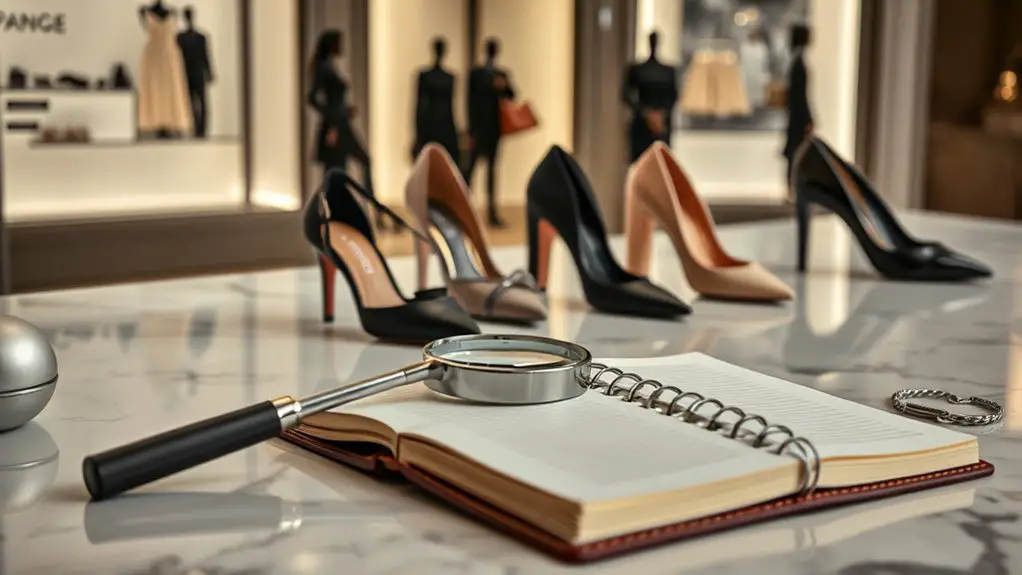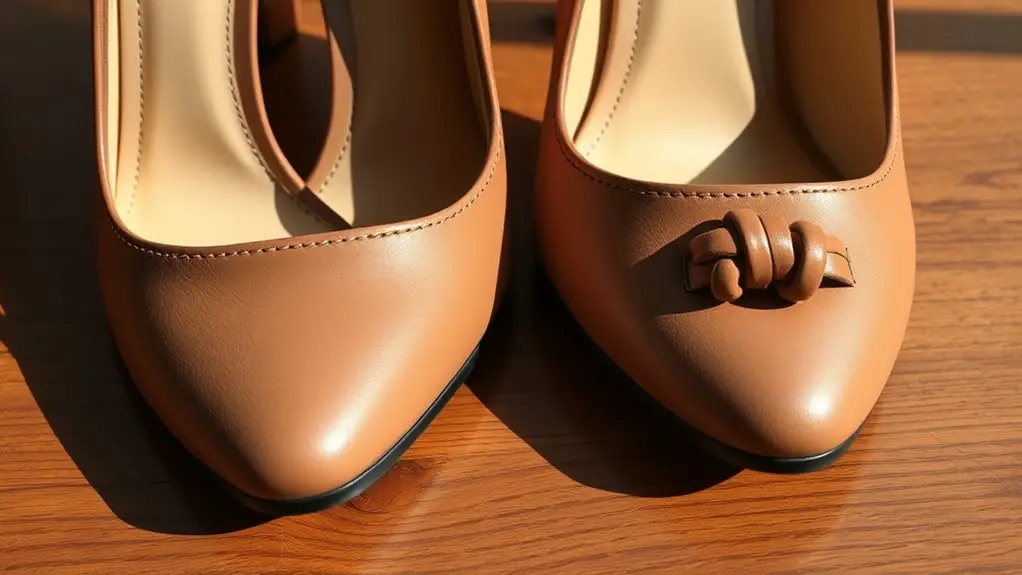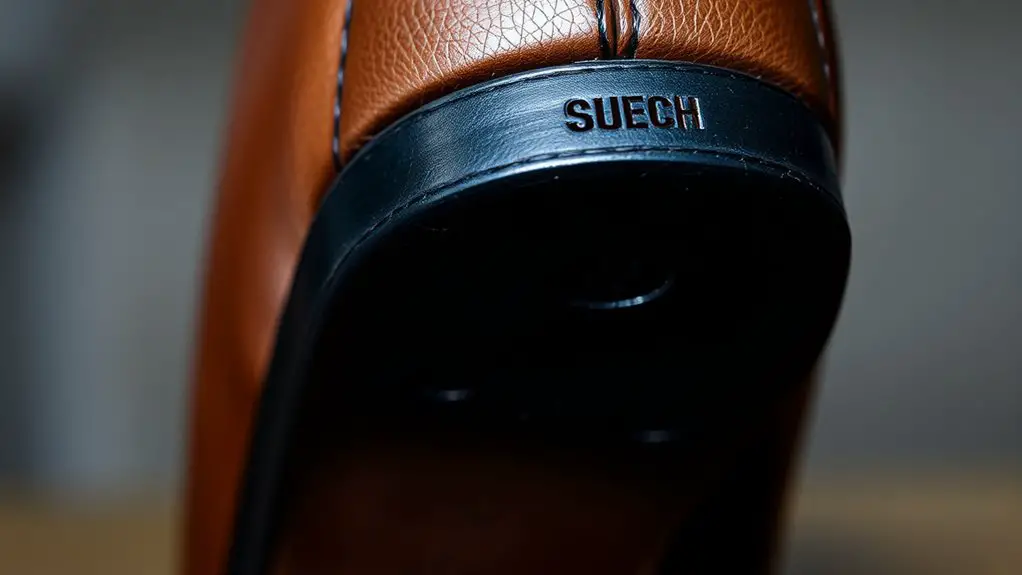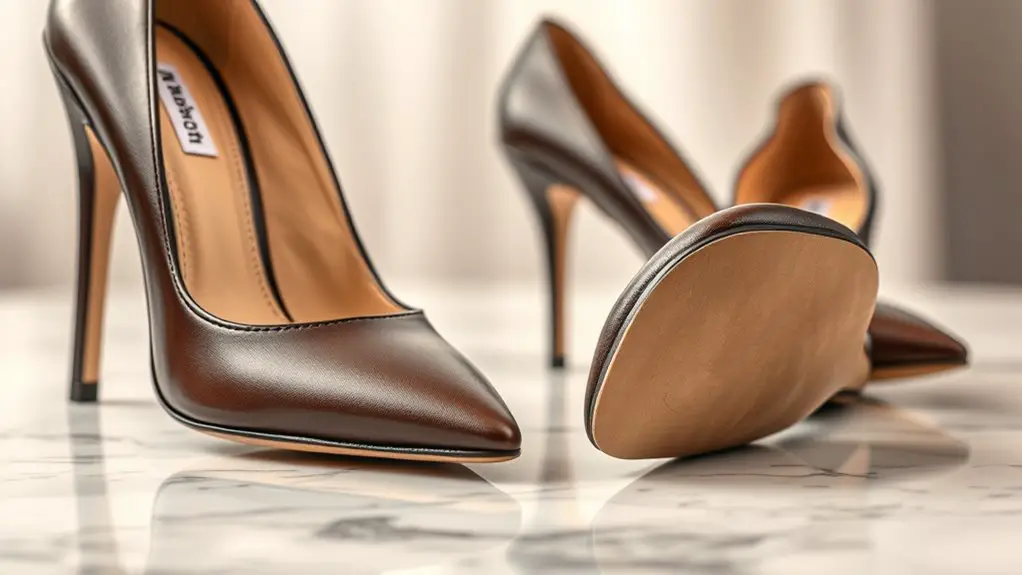To spot fake designer heels, start by researching the brand’s history and signature styles. Pay attention to materials—genuine leather feels soft while imitations can be flimsy. Inspect the stitching; tight, even stitches indicate quality craftsmanship. Check logos for accurate placement and typography, as inconsistencies may signal counterfeits. Don’t overlook the sole’s durability. Be wary of unusually low prices and prioritize trusted retailers. Keep these tips in mind to make sure your next purchase is authentic. There’s more to explore on this topic.
Understanding the Brand: Researching Authenticity

When you’re on the hunt for authentic designer heels, understanding the brand is essential, especially since counterfeiters are becoming increasingly sophisticated. Immerse yourself in the brand history; knowing how a label evolved can reveal its signature styles and unique craftsmanship. For instance, some brands have iconic collaborations with renowned designers that showcase their innovative spirit.
Researching past collections can also help you spot inconsistencies in design or quality. Look for distinctive details that are hallmarks of the brand, like specific stitching patterns or logos. Pay attention to how the brand adapts to trends while maintaining its core identity; this can help you distinguish genuine pieces from replicas.
Examining Materials: Quality vs. Imitation
Having a solid understanding of the brand sets the stage for the next vital step: examining the materials used in designer heels. Authentic designer heels are crafted from high-quality materials that not only look good but also feel luxurious. Pay close attention to the type of materials and their quality indicators.
Understanding the brand is crucial before assessing the luxurious materials that define authentic designer heels.
- Genuine leather should have a soft, supple texture.
- Suede often features a rich, velvety finish, while faux alternatives can feel plasticky.
- Look for sole materials; real designer heels typically use durable rubber or leather.
- Examine the weight; authentic shoes tend to feel sturdier, reflecting their quality.
Analyzing Stitching: the Devil Is in the Details

Stitching often reveals the true craftsmanship behind designer heels, making it an essential element to analyze. When you look closely, you’ll notice the stitch quality is impeccable in authentic designs. Evenly spaced, tight stitches indicate a level of care and expertise that fakes often lack.
Pay attention to thread consistency, too; genuine heels use high-quality thread that matches the material perfectly. If you spot uneven threads or inconsistencies in color, it’s a red flag. Authentic designers often employ techniques like double-stitching for durability and aesthetics, which should be apparent upon inspection.
Also, examine the stitching patterns; they should follow the shoe’s contours seamlessly. If you see loose threads or sloppy work, steer clear. Ultimately, taking the time to analyze these details can save you from investing in counterfeits and help you secure the genuine luxury you deserve.
Checking Logos and Branding: Spotting Inconsistencies
How can you be sure that the logos and branding on designer heels are authentic? One of the easiest ways to spot fakes is to examine the logo placement and branding variations. Luxury brands often have specific guidelines for how their logos appear on products, and even slight discrepancies can indicate a counterfeit. Here are some key points to weigh:
- Check the font style: Authentic logos have precise typography.
- Examine the stitching: Logos should be consistent and cleanly executed.
- Look for color accuracy: Brands often use specific shades that shouldn’t differ.
- Research brand updates: Sometimes, logos evolve, so knowing the current branding can help.
Inspecting the Sole: Functionality and Design

The sole of designer heels is more than just a functional component; it’s a hallmark of quality and craftsmanship. When inspecting the sole, pay attention to the sole design—it should be sleek, often featuring unique patterns or textures that enhance both style and grip. Authentic designer brands prioritize aesthetics while ensuring practical functionality, so check for any unusual shapes or cheap materials that could indicate a fake.
Next, consider sole durability. Genuine designer heels are made with high-quality materials that withstand wear and tear, ensuring they’ll last season after season. If the sole feels flimsy or shows signs of rapid wear, it’s a red flag. Look for reinforced areas, particularly around the heel, as these details reflect the brand’s commitment to enduring quality. By focusing on these aspects, you can confidently distinguish between the real deal and imitations, ensuring your investment is truly worthwhile.
Evaluating Packaging: The Unboxing Experience
Unboxing a pair of designer heels can feel like revealing a treasure, and the packaging plays an essential role in that experience. Authentic high-end brands often invest in sophisticated packaging materials to enhance the unboxing presentation, making it a memorable event. If you’re about to indulge, keep an eye out for these details:
- Quality of the box: Genuine designer boxes are sturdy and well-crafted, often featuring the brand’s logo.
- Tissue paper: High-end brands usually use soft, branded tissue paper to wrap your heels.
- Dust bags: Look for a protective dust bag made from premium fabric—this adds to the luxury feel.
- Care guides and authenticity cards: Legitimate products often include these, ensuring you know how to care for your investment.
Comparing Pricing: Recognizing Red Flags
After revealing your new heels, the excitement can make it easy to overlook one of the most telling signs of authenticity: the price. Always conduct a thorough price comparison before buying. If a pair of designer heels is listed at a fraction of the retail price, that’s a major red flag. Authentic luxury brands rarely drop their prices considerably, even during sales.
Be wary of discount alerts that seem too good to be true. Genuine brands may offer occasional discounts, but if you find steep markdowns or flash sales, it’s likely a sign of fakes.
Research the typical price range for the specific style you’re eyeing. If you can’t find any reputable retailers selling them within that range, it’s time to reconsider your purchase. Trust your instincts; if the deal feels off, it probably is. Your feet deserve the real deal!
Seeking Out Reviews: Learning From Other Buyers
How can you guarantee you’re making a smart investment in designer heels? One of the most effective ways is by seeking out reviews from other buyers. Buyer testimonials and customer experiences can shine a light on the quality and authenticity of the heels you’re considering. Before you hit that purchase button, take a moment to investigate what others have to say.
- Look for detailed reviews that discuss quality, comfort, and fit.
- Pay attention to photos submitted by customers; they often reveal real-world details.
- Watch out for patterns in feedback—consistent issues may indicate a red flag.
- Don’t shy away from asking questions in review sections; genuine sellers appreciate engagement.
Knowing Your Retailers: Trustworthy Sources for Purchase
When you’re on the hunt for authentic designer heels, knowing where to shop is essential. Always prioritize authorized retailers, as they assure legitimacy, while being cautious on online marketplaces where fakes can lurk. Additionally, resale platforms can be a treasure trove, but you’ll need to evaluate each seller to confirm you’re getting the real deal.
Authorized Retailer Identification
While the allure of designer heels can be irresistible, knowing where to purchase them is essential for ensuring authenticity. Shopping from authorized retailers not only guarantees you’ll get the real deal but also comes with several benefits that enhance your experience.
Consider these aspects when identifying authorized dealers:
- Retailer reputation: Look for well-known stores with positive reviews.
- Brand partnerships: Check if the retailer is listed on the designer’s official site.
- Return policies: Authorized dealers often have flexible return options.
- Customer service: Trustworthy retailers provide knowledgeable staff to assist you.
Online Marketplace Caution
Maneuvering the vast world of online marketplaces can be tricky—how can you verify you’re buying authentic designer heels? First, always research the retailer. Check for reviews and ratings; trustworthy sources usually have a solid reputation. Beware of prices that seem too good to be true—these often signal online scams. Look for established retailers with clear return policies and customer service contacts. Marketplace risks are high, especially with sellers who lack transparency. Ascertain the site has secure payment options, and don’t hesitate to ask questions before purchasing. If the seller’s response is vague or evasive, it’s a red flag. Protect yourself by making informed choices, so you can strut confidently in your new designer heels without fear of counterfeit mishaps.
Resale Platforms Evaluation
As you explore resale platforms for designer heels, it’s vital to evaluate the credibility of each retailer to verify you’re investing wisely. A platform’s reputation can greatly influence your purchasing experience. Look for these key indicators:
- Verified sellers: Ascertain the platform has a method for verifying sellers’ authenticity.
- Buyer protection policies: Check for strong policies that safeguard your purchase, like return options and fraud protection.
- Customer reviews: Read through reviews for insights on previous buyers’ experiences.
- Authenticity guarantees: Choose platforms that offer guarantees on the authenticity of their products.
Frequently Asked Questions
How Can I Tell if a Seller Is Reputable?
When diving into the sea of online shopping, check the seller reviews like a lighthouse guiding your way. A solid purchase history reflects trust; don’t let a murky reputation capsize your fashion dreams.
What Should I Do if I Suspect My Heels Are Fake?
If you suspect your heels are fake, act quickly. Consider reporting fakes to the seller or platform, and don’t hesitate to return purchases. Authenticity matters, and you deserve the quality you paid for.
Are There Specific Websites to Avoid When Buying Designer Heels?
Maneuvering the digital marketplace can feel like walking through a minefield. Online marketplaces to avoid often display red flag signs, like prices too good to be true. Stay vigilant and trust your instincts when shopping.
How Do Counterfeit Heels Affect the Resale Market?
Counterfeit heels considerably impact the resale market, decreasing resale value for authentic pairs. When buyers can’t trust quality, it creates skepticism, leading to lower demand for genuine designs. You’ll want to be careful where you invest.
Can I Authenticate Designer Heels After Purchasing Them?
If you’ve already made a purchase, you can still seek peace of mind through various authentication methods. Examine designer heel features closely; even subtle details can reveal their true identity and confirm your investment’s authenticity.



